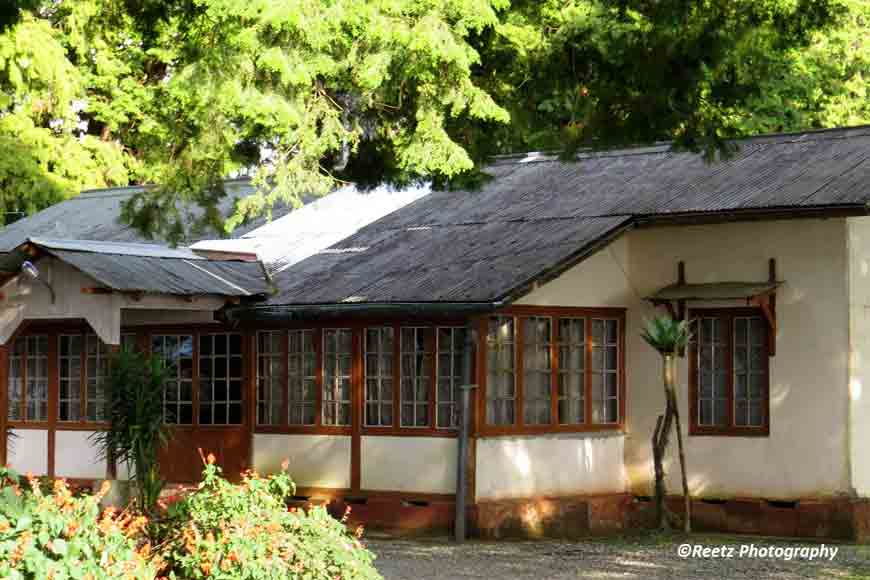Solitary trek to a haunted bungalow of Ramdhura

Reetwika Banerjee is a Cyber Security Expert by profession, an avid traveller, a shutterbug and a nature explorer.
Ramdhura, around 95 kilometres from New Jalpaiguri station, is an upcoming hill station in the Kalimpong district of West Bengal. It is perched at an altitude of 5800 feet above sea level and surrounded by untainted Pine Dhupi (forest as they mean in Bhutia language). Soon after crossing Algarah bazaar, just one sharp hilly bend and we suddenly discovered ourselves within a thick canopy of cedar and pine woodlands. Landscapes change so fast here. Our driver mentioned that we were passing through the Munsong Forest.
 Way Through Pine Dhupi
Way Through Pine DhupiThere are no luxury hotels in Ramdhura hitherto, but it offers an array of Bhutia homestays to the handful of tourists who land on this little paradise. Needless to say, the hosts are yet to learn the basic art of hospitality which any vacationer would expect. There was a very thrilling destination within a couple of kilometres of our stay. It’s a vintage British bungalow whose original name is not known to anybody. The place around the bungalow was rich in flora and fauna, especially Himalayan medicinal plants like Cinchona.In those days, malaria was an epidemic and its remedial supply was extremely crucial.
 Walk Through Munsong Cinchona Plantation
Walk Through Munsong Cinchona PlantationDuring 1901, the Munsong Cinchona Plantation was established for commercial cultivation of the plant. Few years later, in 1930 a lavish bungalow was built within the plantation campus for the Director’s stay. It is said that Sir Ronald Ross had also been here. When the British deserted the bungalow after India’s independence, it was taken over by West Bengal Government, and they renamed it to ‘Jalsa Bungalow.’ Even after the handover, it continued to be the Cinchona Plantation Manager’s family quarters, but ever since a series of spooky incidents that took place around the bungalow, it started being professed as a haunted shelter by locals.
 Entry Gate Of Jalsa Bungalow
Entry Gate Of Jalsa BungalowWe verified the myth from our driver before starting our trek. Villagers who had experienced eerie incidents inside the bungalow said there is a spirit inside the bungalow that often takes the shape of an old caretaker to visitors. He offers information about the rich history of the quinine factory of Munsong, takes order for dinner, prepares the table but never returns with the food. Upon investigation it had been found that there were no such custodians employed for the maintenance of the bungalow. There were only a few gardeners from the quinine factory who maintained the adjoining garden and trees. Today, nobody goes there after sunset, neither anyone dares to stay at night.
 Way To Jalsa Bungalow Inside The Quinine Factory Campus
Way To Jalsa Bungalow Inside The Quinine Factory CampusWhat could have been a better motivation to visit the bungalow? It was 2.30pm and was the perfect time to overlook a mesmerizing view of sunset from the Jalsa Bungalow. After about an hour’s trek, we reached the Munsong Cinchona Plantation entrance. On our left was the gurgling sound of Teesta River, while on the other side were sounds of whistling cedars, and a corroded shoulder height half-open grill gate in front – beckoning us inside. Chills ran down our spine, as we gently pushed the gate to step in.
Also Read
TRAVEL WITH GB TO THE ‘VILLAGE OF MIST’
 A Sharp Bend
A Sharp BendThe hissing sound of the heavy cold air created a mystic environment. After walking for another half kilometre inside the planation area, there was a steep bend and ‘The Jalsa Bungalow’ was right in front of us. It was such a beauty. Every bit of it was expressing the grandeur of its past. The remarkable woodworks which could pass the test of time still looked impressive. As expected, the main door was locked from outside. But we could not resist ourselves from exhibiting a weird activity, very unusual of us. We peeped in through the dustyglass panes to sneak a quick look of the bungalow’s interiors. It was quite dark, but still lighted enough to glance through. The area we were peeping into was the hallway. There were beautiful antique furniture of British era scattered around.
 Garden Adjacent To Jalsa Bungalow
Garden Adjacent To Jalsa BungalowThe temperature outside was dropping sharply, creating a mist of our breaths on the glasses. The moment we imagined an unworldly company in the surroundings, our fingers trembled and we almost jerked away from the window, as if some electric shock threw us off. The experience was enough to satiate our spooky hunger. It was twilight then. We did not go back towards the bungalow again. The adjacent gardens were full of colourful Himalayan flowering plants and tall cedars. At one side of the garden, there was an old seating lounge overlooking the Teesta River, which perhaps served as a panoramic view point in those days. Lack of maintenance made it look all tarnished today. Nevertheless, the grand view of twelve turns of Teesta River, longest as they say, with the setting sun behind the blue mountains was a treat to our eyes.
 Viewpoint In Front Of The Jalsa Bungalow Overlooking Teesta River
Viewpoint In Front Of The Jalsa Bungalow Overlooking Teesta RiverTaking a stroll around the complex, we did not wait further. The trail back to our homestay was through a dense pine forest and leopard sighting was quite common after sunset. Even so, no harm in saying, to get the widest bird’s eye view of meandering Teesta River, a vintage British architecture along with Mt. Kanchenjunga in one frame, one must be at Ramdhura’s historic Jalsa Bungalow.
 Birds Eye View Of Teesta From Jalsa Bungalow
Birds Eye View Of Teesta From Jalsa Bungalow










